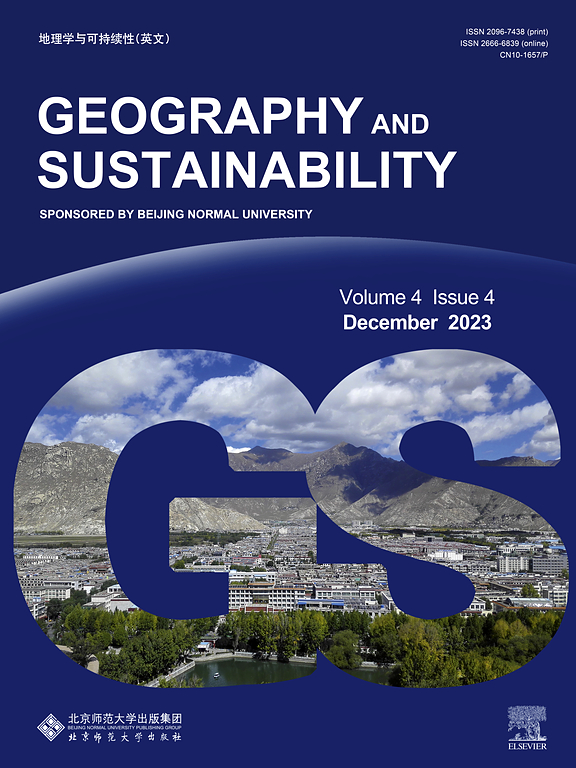Land use changes and their effects on poverty in Inner Mongolia, northern China
IF 8
1区 环境科学与生态学
Q1 GEOGRAPHY, PHYSICAL
引用次数: 0
Abstract
The effects of land use changes on poverty vary markedly among geographic regions. While Inner Mongolia has been experiencing significant land use changes during past decades, to date there has been no systematic research aimed at understanding how these land use changes affect poverty in the region. This study analyzes spatiotemporal patterns of land use changes in Inner Mongolia from 1980 to 2020 through the application of statistical methods including Correlation Analysis, Multiple Stepwise Regression Analysis, and Geographically Weighted Regression to understand how land use changes affect the distribution and dynamics of poverty. We show that five types of land use conversion explain 51 % of the variation in poverty levels. Conversions among cultivated land, grassland, and construction land are shown to have dominated the pattern of land use change in Inner Mongolia. From 2000 to 2020, 2,208 km2 of grassland and 56 km2 of water/wetland were converted to built-up land, and 32 km2 of water/wetland was converted to woodland, these conversions promoted poverty reduction. Conversely, the conversion of existing cultivated land to grassland and its degradation to unused land (1,754 km2 and 156 km2, respectively) has constrained progress in alleviating poverty in the region. Accordingly, further mitigation of poverty in Inner Mongolia can be obtained through interventions that conserve remaining cultivated land, while simultaneously facilitating urbanization. Maintaining the dynamic balance between economic growth and environmental protection is key to the development of policies that advance sustainability in this region. Moreover, the methodology used in this study has the potential to be applied to other regions of the world with similar environmental and socioeconomic conditions to support sustainable land use planning in the context of poverty reduction.

内蒙古土地利用变化及其对贫困的影响
不同地理区域的土地利用变化对贫困的影响差别很大。虽然内蒙古在过去几十年中经历了重大的土地利用变化,但迄今为止还没有系统的研究旨在了解这些土地利用变化如何影响该地区的贫困。本文运用相关分析、多元逐步回归分析和地理加权回归等统计方法,分析了1980 - 2020年内蒙古土地利用变化的时空格局,以了解土地利用变化对贫困分布和动态的影响。我们发现,五种土地利用转换类型解释了51%的贫困水平变化。耕地、草地和建设用地的转换主导了内蒙古土地利用的变化格局。2000 - 2020年,全国共实现2208平方公里草地、56平方公里水湿地和32平方公里水湿地的建成地改造,促进了减贫。相反,现有耕地向草地的转化和未利用地的退化(分别为1754平方公里和156平方公里)限制了该地区减贫的进展。因此,可以通过保护剩余耕地的干预措施,在促进城市化的同时,进一步减轻内蒙古的贫困。保持经济增长和环境保护之间的动态平衡是制定促进本地区可持续性政策的关键。此外,本研究中使用的方法有可能应用于世界上具有类似环境和社会经济条件的其他区域,以支持减贫背景下的可持续土地利用规划。
本文章由计算机程序翻译,如有差异,请以英文原文为准。
求助全文
约1分钟内获得全文
求助全文
来源期刊

Geography and Sustainability
Social Sciences-Geography, Planning and Development
CiteScore
16.70
自引率
3.10%
发文量
32
审稿时长
41 days
期刊介绍:
Geography and Sustainability serves as a central hub for interdisciplinary research and education aimed at promoting sustainable development from an integrated geography perspective. By bridging natural and human sciences, the journal fosters broader analysis and innovative thinking on global and regional sustainability issues.
Geography and Sustainability welcomes original, high-quality research articles, review articles, short communications, technical comments, perspective articles and editorials on the following themes:
Geographical Processes: Interactions with and between water, soil, atmosphere and the biosphere and their spatio-temporal variations;
Human-Environmental Systems: Interactions between humans and the environment, resilience of socio-ecological systems and vulnerability;
Ecosystem Services and Human Wellbeing: Ecosystem structure, processes, services and their linkages with human wellbeing;
Sustainable Development: Theory, practice and critical challenges in sustainable development.
 求助内容:
求助内容: 应助结果提醒方式:
应助结果提醒方式:


